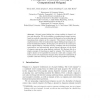Free Online Productivity Tools
i2Speak
i2Symbol
i2OCR
iTex2Img
iWeb2Print
iWeb2Shot
i2Type
iPdf2Split
iPdf2Merge
i2Bopomofo
i2Arabic
i2Style
i2Image
i2PDF
iLatex2Rtf
Sci2ools
AISC
2004
Springer
2004
Springer
Proving and Constraint Solving in Computational Origami
Abstract. Origami (paper folding) has a long tradition in Japan's culture and education. We are developing a computational origami system, based on symbolic computation system Mathematica, for performing and reasoning about origami on the computer. This system is based on the implementation of the six fundamental origami folding steps (origami axioms) formulated by Huzita. In this paper, we show how our system performs origami folds by constraint solving, visualizes each step of origami construction, and automatically proves general theorems on the result of origami construction using algebraic methods. We illustrate this by a simple example of trisecting an angle by origami. The trisection of an angle is known to be impossible by means of a ruler and a compass. The entire process of computational origami shows nontrivial combination of symbolic constraint solving, theorem proving and graphical processing.
AISC 2004 | Artificial Intelligence | Computational Origami | Computational Origami System | Origami |
| Added | 20 Aug 2010 |
| Updated | 20 Aug 2010 |
| Type | Conference |
| Year | 2004 |
| Where | AISC |
| Authors | Tetsuo Ida, Dorin Tepeneu, Bruno Buchberger, Judit Robu |
Comments (0)

